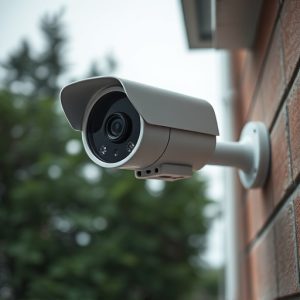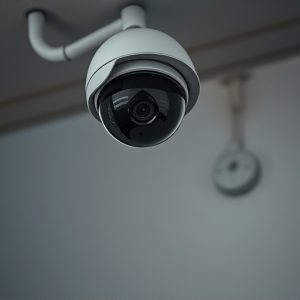Outdoor Fake Camera: Benefits, Placement, Types & Legal Implications
Outdoor fake camera installations offer an affordable way to boost security by mimicking real survei…….
Outdoor fake camera installations offer an affordable way to boost security by mimicking real surveillance setups at strategic heights (5-10 feet) for maximum deterrence. These decoys, placed at eye level or higher, mislead intruders and reduce break-ins, vandalism, etc., while providing flexible placement and improved field of view. Installation should consider environmental factors and human perceptional norms, balancing security needs with privacy concerns, especially in public areas, where local laws must be adhered to.
“Uncover the power of deterrence with outdoor fake camera installation—a creative solution for enhancing security without breaking the bank. This article explores the concept of empty security camera housing units, known as fake cameras, and their role in dissuading potential intruders. We delve into the benefits of this cost-effective measure, including improved safety and peace of mind. Understanding optimal height placement is key; learn about factors influencing its effectiveness. Discover various types of fake cameras and their unique features, plus essential legal and ethical considerations.”
- Understanding the Concept of Empty Security Camera Housings
- Benefits of Outdoor Fake Camera Installation
- Factors to Consider for Optimal Height Placement
- Types of Fake Cameras and Their Features
- Legal and Ethical Implications: What You Need to Know
Understanding the Concept of Empty Security Camera Housings
Empty security camera housing units, often referred to as decoys or fake cameras, are a clever and cost-effective way to enhance outdoor security. These devices mimic real camera setups, providing a visual deterrent to potential intruders. By strategically placing them at various heights, typically in the 5-10 foot range (ideal for Outdoor Fake Camera Installation Height), property owners can create the illusion of constant surveillance, thus discouraging criminal activity.
The concept is simple yet powerful: criminals are less likely to target areas where they believe they’re being watched. These housing units, when placed in plain sight, can significantly reduce break-ins, vandalism, and other malicious activities. They serve as a visual reminder that security measures are in place, even if the actual camera technology might be non-existent or hidden elsewhere.
Benefits of Outdoor Fake Camera Installation
An Outdoor Fake Camera Installation offers a myriad of benefits for enhancing security and deterring potential criminals. One of the key advantages is its visual impact. These realistic camera units, often designed to mimic real security cameras, can be placed at various strategic heights, from tall poles to wall-mounted fixtures. This clever tactic misleads intruders, creating the perception of a fully functional surveillance system. Even if the cameras are not recording, their mere presence can act as a powerful deterrent.
Additionally, fake cameras provide a cost-effective solution compared to installing multiple genuine security cameras. They offer flexibility in terms of placement and positioning, allowing property owners to focus their resources on other security measures while maintaining an air of protection. The height at which these decoys are placed can further contribute to their effectiveness, ensuring a broader field of view and improved coverage for the entire premises.
Factors to Consider for Optimal Height Placement
When planning the outdoor fake camera installation height, several factors come into play to ensure optimal visibility and deterrence. The placement should consider the average eye level of individuals in the area, typically around 5-6 feet (1.5-1.8 meters) above ground level. This ensures the camera has a clear view without appearing overly intrusive or obvious.
The environment’s characteristics are also crucial. In urban settings with tall buildings or dense vegetation, adjusting the height to capture a broader area might be necessary. Conversely, in rural locations with lower obstacles, a standard eye-level position should suffice. Additionally, factoring in potential obstacles like trees or signs that could obstruct the camera’s view is essential for a successful installation.
Types of Fake Cameras and Their Features
Fake security cameras, also known as decoy or dummy cameras, come in various forms designed to deter potential criminals. One common type is the outdoor fake camera, strategically placed at different installation heights to simulate a fully functional surveillance system. These replicas often feature detailed designs that mimic real cameras, complete with lenses and lights, making them an effective visual deterrent.
Different models offer adjustable mounting options, allowing for placement at eye level, on poles, or even hidden in trees or overhead structures, simulating diverse outdoor fake camera installation heights. This versatility ensures property owners can choose the best location to enhance security without compromising aesthetics. The key advantage lies in their ability to deceive intruders, creating the illusion of constant surveillance, thereby discouraging criminal activity.
Legal and Ethical Implications: What You Need to Know
The installation of outdoor fake camera units, at optimal heights like 10 feet or more, is a double-edged sword that cuts across legal and ethical boundaries. While it offers enhanced security for homes and businesses by deterring potential intruders, it raises significant privacy concerns among neighbors and passersby. In many regions, the placement of surveillance equipment is governed by strict laws designed to protect individual freedom and privacy rights. Property owners must be aware of these regulations, which often dictate the visible placement of cameras, their operational capabilities, and the types of data that can be recorded and stored.
Ethical considerations further complicate the matter. Fake cameras might create a false sense of security for their owners while inadvertently encouraging a culture of surveillance among communities. It’s crucial to balance the need for safety with respect for personal privacy and freedom. Property owners should also consider the potential impact on wildlife and local ecosystems, especially in natural areas where such installations could disrupt habitats. Understanding these legal and ethical implications is paramount before deploying outdoor fake camera systems.
Empty security camera housing units, when strategically placed outdoors through considered outdoor fake camera installation height, offer a cost-effective and legal deterrent for potential criminals. By utilizing these units and understanding key factors like optimal placement and available types, homeowners and businesses alike can enhance their security without breaking the bank. Remember that responsible use respects privacy laws while maximizing safety benefits.


